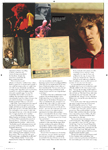|
The
Making Of 'Tim Buckley' - Part Three
The
actual Tim Buckley album attests to just how rapidly the singer-songwriter
was developing, both in terms of his songs and their settings.
Feels Beckett: “You go into the studio for Tim Buckley,
and you have a very artistic approach. I think the primary
difference is the focus on Tim’s guitar. He was always
experimenting with chord positions and arpeggios of different,
strange varieties and deeply involved in arranging and rearranging,
as well as composing – trying to figure out the most
beautiful way to embody that, while playing guitar, either
six- or twelve-string. Like the flatted fifth on I Can’t
See, it starts right there. If you listen carefully all
the way through, his playing is really pushed to the fore.
Tim’s guitar, all of a sudden, is now fore-grounded.”
 |
In addition to attending and giving input during all of the
sessions, Larry also wrote a “vast prose poem” for
the sleevenotes that went unused, though a shorter Beckett
poem, 1, 2, 3 (written to Tim), appears in the deluxe
edition’s booklet.
“It
shows you how quickly growth and change impacted upon Tim
in those days,” says Fielder of the debut LP. “You’re
talking about a span of less than a year between when the
demo was made and when we finally get into recording Tim’s
first album. Tim and Larry had just never stopped writing,
and everything they did, they got more experience, and were
better educated. Everything they did was better than what
had come before.
“The
only thing that surprises me about that first album of Tim’s
is that it didn’t sell very well. My wife thought that
it was too smart for the audience at the time. It kind of
points to the potential that people like Jac Holzman saw in
Tim. Here was someone who was always going to be coming up
with new and probably better things, and it just kind of bore
that out.”
“It’s
almost unfair to compare the demo with Tim’s first album,
because the demo was basically made under difficult conditions;
someone turned on a mike, and we started playing and singing.
As compared to an album that’s made with Paul Rothchild
[who co-produced the LP with Jac Holzman] and [engineer] Bruce
Botnick at the controls, in a fully first-class [Los Angeles]
studio like Sunset Sound.”
In
Jim’s estimation, lead guitarist Lee Underwood, who’d
play on numerous Buckley albums throughout Tim’s career,
“was probably the best musical influence in those sessions.
Everyone kind of based what they were doing around what he
was doing. Every now and then, Paul or Bruce would have a
comment about something the drums or guitar were doing, saying,
‘maybe this could be a little different here‘. But,
basically, it was Lee who kind of led the way as far as those
arrangements go.”
Listening
to Disc One of the new deluxe edition, Fielder related that,
“To my surprise, I preferred the mono mix on every track
but She Is. Stereo was, at that time, a very new game
and few kids could afford the equipment. The mono mix back
then, for pop music, was the standard, and most engineers
used stereo pretty fundamentally, as on this album: the guitars
on the right, the bass and drums on the left, and the vocal,
strings, and solos in the middle.
“The
mono mix is the one that sounds more like what you would hear
in a concert hall: everything coming from a single source.
Tim was a ferocious stage presence, and the best way to hear
him was as if in live concert.”
More
Buckley reissues are in the pipeline, with bonus material
under consideration for Goodbye & Hello’s
deluxe edition including a half dozen acoustic demos (among
them the never-to-appear-on-record Sixface) recorded
in producer Jerry Yester’s living room; an acetate of
different demos for the same LP, including several songs that
would be re-recorded for the album, and some that wouldn’t
make it onto the record; the unissued single Once Upon
A Time/Lady Give Me Your Key (whose A-side was recently
released on the Where The Action Is: Los Angeles Nuggets
box set); and studio session tapes of a few songs.
That’s
not even counting another demo tape Beckett recalls from around
1966 that hasn’t been found, where Herb Cohen had, “Fielder,
Buckley, and I go into a studio and record everything we’d
written as a safety. It was a good acoustic performance, and
had scads of material that has never appeared anywhere else.”
Could
there be even more in the vaults – more unearthed live
performances, such as the March 1967 gig issued in 2009 on
Live At The Folklore Center? Don’t discount the possibility.
For as Larry Beckett told me when I first interviewed him
more than ten years ago, “Tim was ready to put out a
five-album set. He loved so many kinds of music, and was so
accomplished at performing them all, that limiting him to
two sides of an LP was almost ridiculous.”
| Record
Collector is the world's leading authority on rare and
collectable records. Launched in 1979, it is now the UK's
longest-running music magazine. |
|